While the rest of the world was two iterations ahead of me playing The Elder Scrolls V: Skyrim, I was off stealing pillows, sowing the seeds of political discord, and poking bears in The Elder Scrolls III: Morrowind and its two expansions, Tribunal and Bloodmoon. Packaged together in the Game of the Year Edition, these three games comprise one continuous world that isn’t so much an RPG as it is a sandbox with a final boss or three. To give you a sense of this game’s scope, it took me an estimated 200 hours spread across an entire year to beat the three main quests—in roughly that same amount of time, I could have played through Final Fantasy I, II, III, IV, V, VI, VII, and VIII, or earned three PhDs.
And I only saw about half of what the game has to offer.
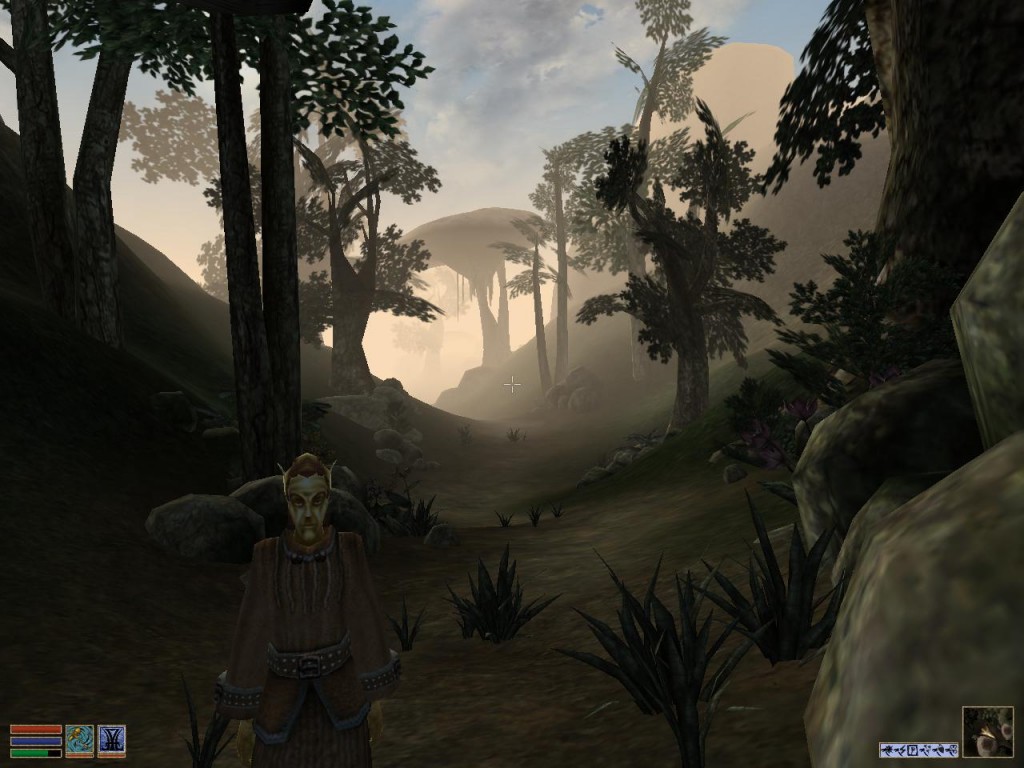 Yes, I have a triple doctorate in escorting bozos like this one to their destination.
Yes, I have a triple doctorate in escorting bozos like this one to their destination.
With an impressive amount of character customizability, an overwhelming variety of memorable quests and creatures, an astounding degree of freedom to do as you please, an intricate plot, dated graphics kept fresh by gorgeous landscapes and creative architecture, tremendous attention to detail in virtually every aspect of the game, and a soundtrack so good you’ll barely notice the repetition of the same 20 tunes, The Elder Scrolls III is an incredible and wholly immersive gaming experience that comes recommended to absolutely anyone who no longer cares about the outside world—no previous experience with The Elder Scrolls series necessary.
That’s the short review. The long version involves blatant human rights violations in the name of an escort quest, saving the world while intoxicated, excessive vigilante justice, and a helmet made of asparagus.
See? See? Doesn’t it look like asparagus??
Morrowind casts you as some fresh-off-the-boat, no-name adventurer poised to unravel a mystical prophecy and save the land (Vvardenfell) from the terrible ash storms and great evil emanating from the center of the continent. You’ll traverse swamps, grasslands, and mountains; you’ll fight powerful spellcasters, plague-ridden beasts, and legions of undead; you’ll fetch valuable artifacts from ancient ruins, solve a murder mystery, and swear an oath to the god Zenithar that’s you’ll deliver these five shirts to a town, but then completely forget about the entire quest and the oath you swore, sell the shirts, and wonder for two months why nobody in town will do business with you until you’ve fulfilled whatever oath they keep talking about.
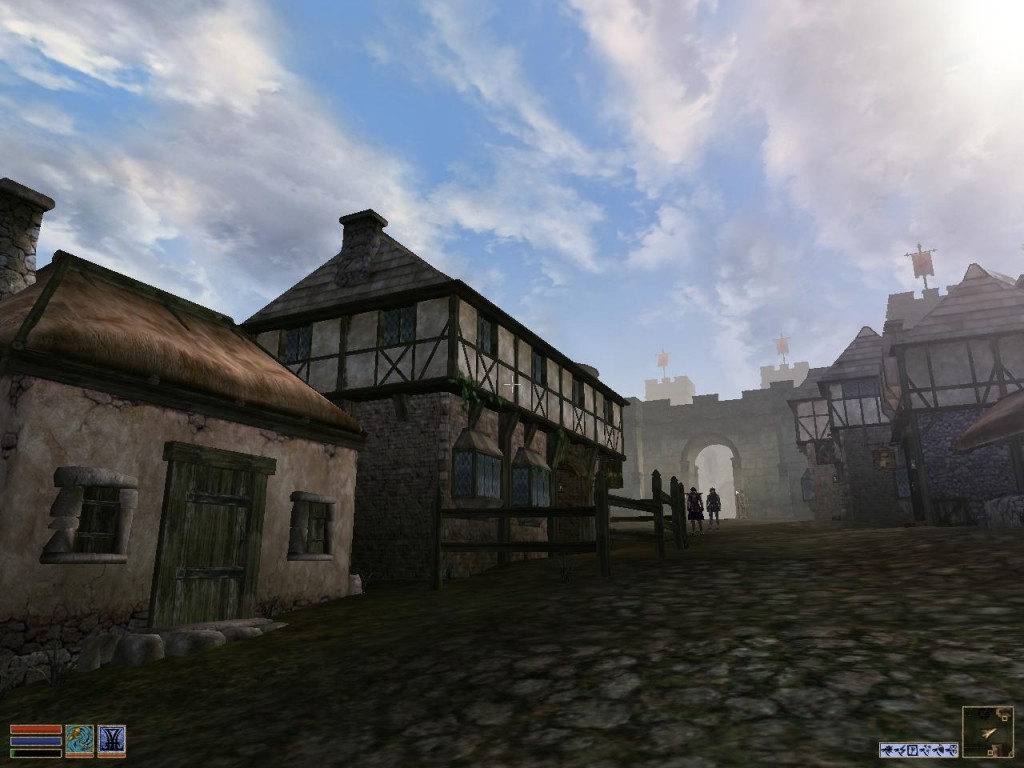 A screenshot of Morrowind.
A screenshot of Morrowind.
Tribunal primarily takes place within (and below, and then nowhere remotely close to) the walls of a city (Mournhold) that’s not even on your world map. The city is gripped by political and religious turmoil, with a host of dark and sinister things being…uh…dark and sinister things, down in the sewers and caverns. There are sidequests aplenty, though; there’s a bar in need of a bouncer, a museum collecting famous artifacts from around the world, and an opportunity to play (horrible, horrible) matchmaker with the locals, to name a few. Tribunal is visually impressive but frequently unphotogenic—lots of big, open spaces that are neat to explore, but difficult to capture—so the fact that most of the images in this review are from Morrowind or Bloodmoon is only slightly playing favorites.
 A screenshot of Tribunal.
A screenshot of Tribunal.
Bloodmoon invites you to a large, snowy island (Solstheim) that’s rife with werewolves, tree spirits, and tusky little sea mammals called horkers. There you’ll search for a crashed airship, break into an imposing ice fortress, and help build (or sabotage, you jerk) a mining colony. Of course, there’s another prophecy you’re bound to get mixed up in somehow, too, but it’s mostly an excuse to kill stuff dead.
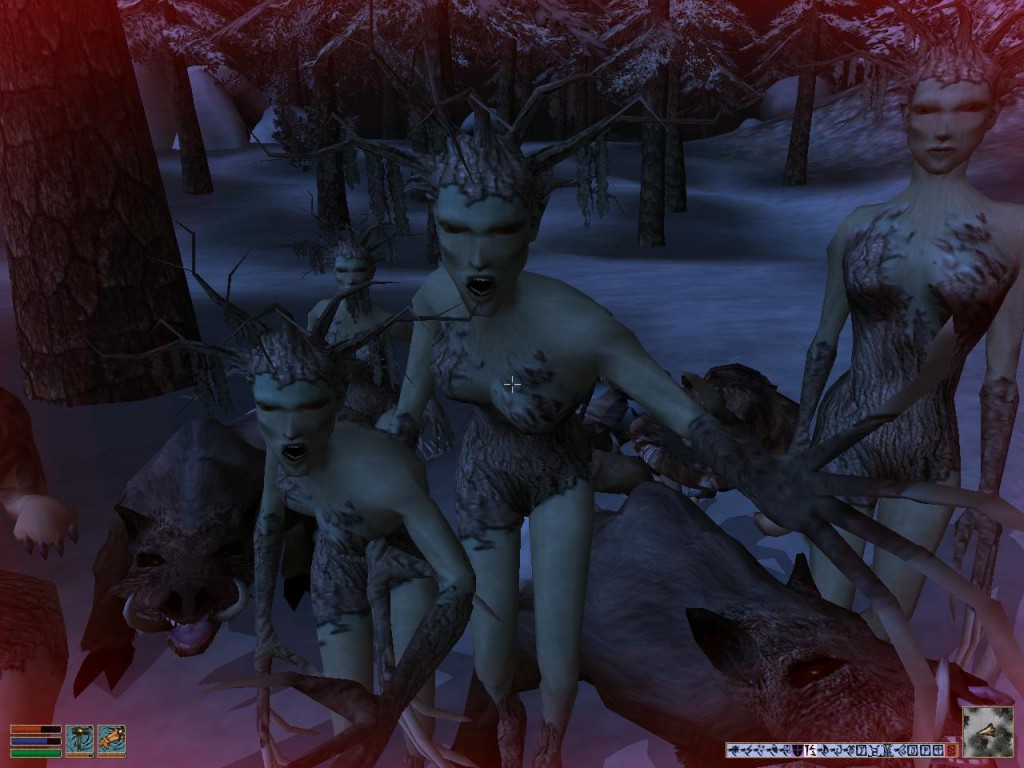 WHY DID I USE THE SCARY SCREENSHOT. STAY BACK, CREEPY TREE LADIES.
WHY DID I USE THE SCARY SCREENSHOT. STAY BACK, CREEPY TREE LADIES.
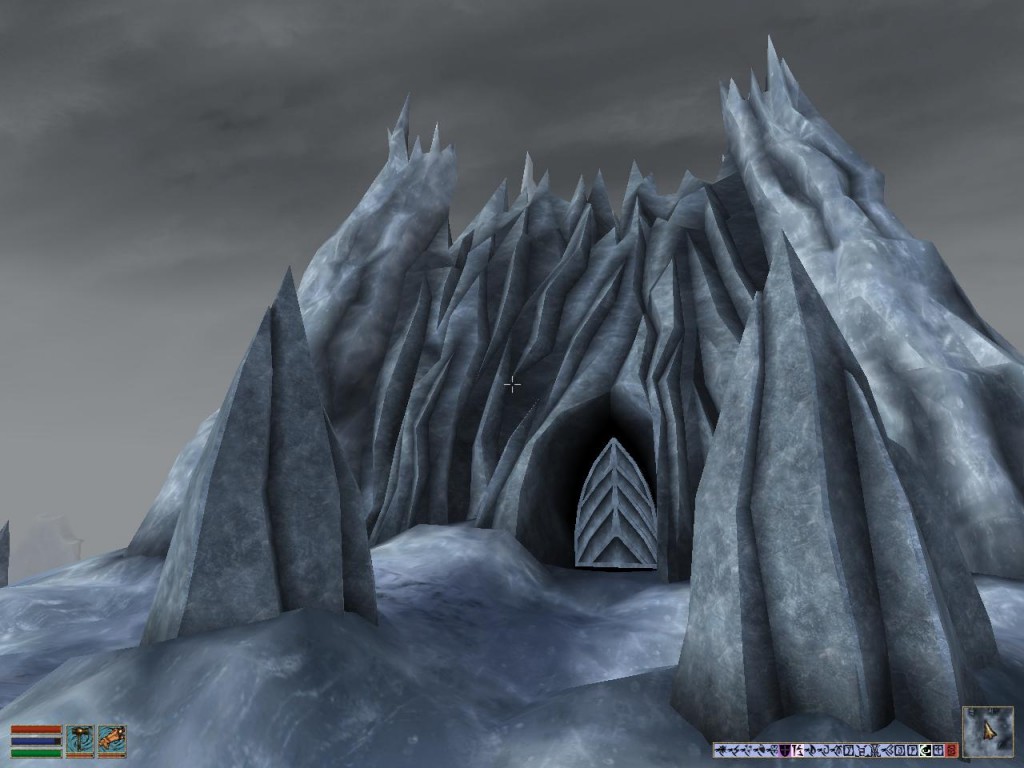 ::ahem:: A screenshot of Bloodmoon.
::ahem:: A screenshot of Bloodmoon.
The two expansion packs really are expansions of the original game, providing new and different quests, characters, enemies, items, etc. in locations that are self-contained, but still accessible from Morrowind. The content may be different for each game, but the overall feel is fairly consistent; it’s the approach to the storytelling that fundamentally differentiates each game. Whereas Tribunal seems to have built the city around the story, Bloodmoon gives the impression that the story was built around the island—instead of having a quest-giver send you on a dungeon crawl, here you embark on a dungeon crawl in search of a quest-giver. (In Soviet Solstheim, quest gives you!) Somewhere between these two styles lies Morrowind, so there’s something for everyone.
There’s also a handful of official plug-ins released by Bethesda that expand the game a little further (which come recommended), and no shortage of player-created mods—The Elder Scrolls III has enjoyed incredible longevity thanks to a very active fan community dedicated to fixing bugs, expanding the world even further, and making all the character models anatomically correct. As if that weren’t enough, the game comes with a map editor that—as far as I can tell from staring at the interface for 15 seconds—has too many buttons. Needless to say, it’s robust. If “robust” is a synonym for “has too many buttons.”
 One of my favorite quests in the game comes from an official plug-in. I like the theatrical skeleton on the right.
One of my favorite quests in the game comes from an official plug-in. I like the theatrical skeleton on the right.
My voyage through Vvardenfell, Mournhold, and Solstheim was characterized by a series of phases that, on paper, look like The Five Stages of Grief mated with the Twelve-Step Program. I denied that I was addicted to Morrowind, got angry that I could escape by turning to a higher power (in my case and this context, a Mega Man game), bargained with my wife to stay up a little longer playing this game I admitted I was addicted to, got depressed making amends to the people in-game whom I’d harmed, and accepted the fact that I’d have to write a review to share my experiences with all who might play Morrowind.
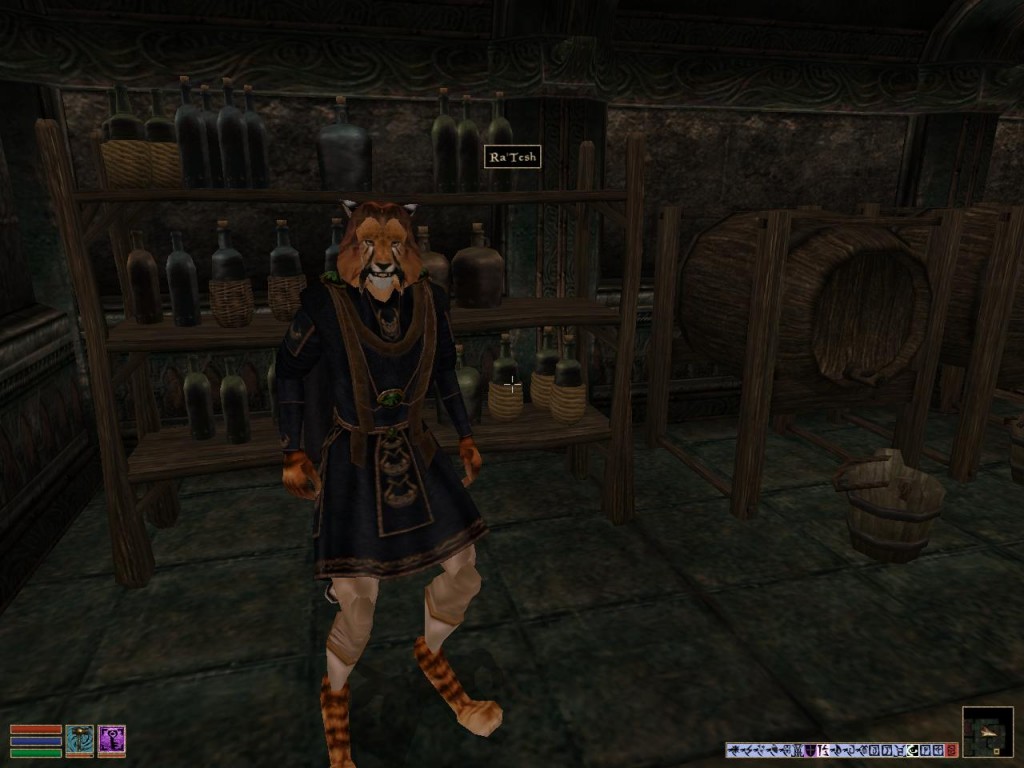 Grab a drink. This might take a while.
Grab a drink. This might take a while.
I freely admit that, for the first 100 hours, I had absolutely no idea what I was doing. A wizard fell out of the sky and left me with a mighty hammer. An assassin tried to kill me in my sleep, and I stole his outrageously overpowered armor. After being murdered once. (I quicksave often.) From very early on in the game, I was outfitted to play Morrowind on my own terms—filling out my world map, beating things with a hammer, and ignoring commoners if they had anything more intelligent to say than, “Welcome to Seyda Neen! We smell like fish.” I was simply not prepared to wrap my head around a story-heavy game of such complexity, so I started out playing it as the mindless criminal training simulator it was never meant to be.
I mean, who can process this much information?
When you create a new character in Morrowind, you are given the option of having the computer recommend a certain build, based on your answers to a series of questions about hypothetical situations like, “Suppose Timmy has fallen down a well. Do you (a) throw him a rope and hoist him up; (b) throw rocks at him until he cries; or (c) throw a lid on the well and seduce his wife?” Through a series of decisions highlighting my propensity for diplomacy, puzzle-solving, and being an all-around good guy, I ended up as Jora Uln, Witchhunter, a burly Nord with Personality as his dump stat who specialized in stealth, defensive magic, and beating things with a hammer.
Because of—and in spite of—my character build and playing style, I spent the majority of the game engaging in some combination of the following activities:
– Learning scads of magic spells, only to use, like, three of them
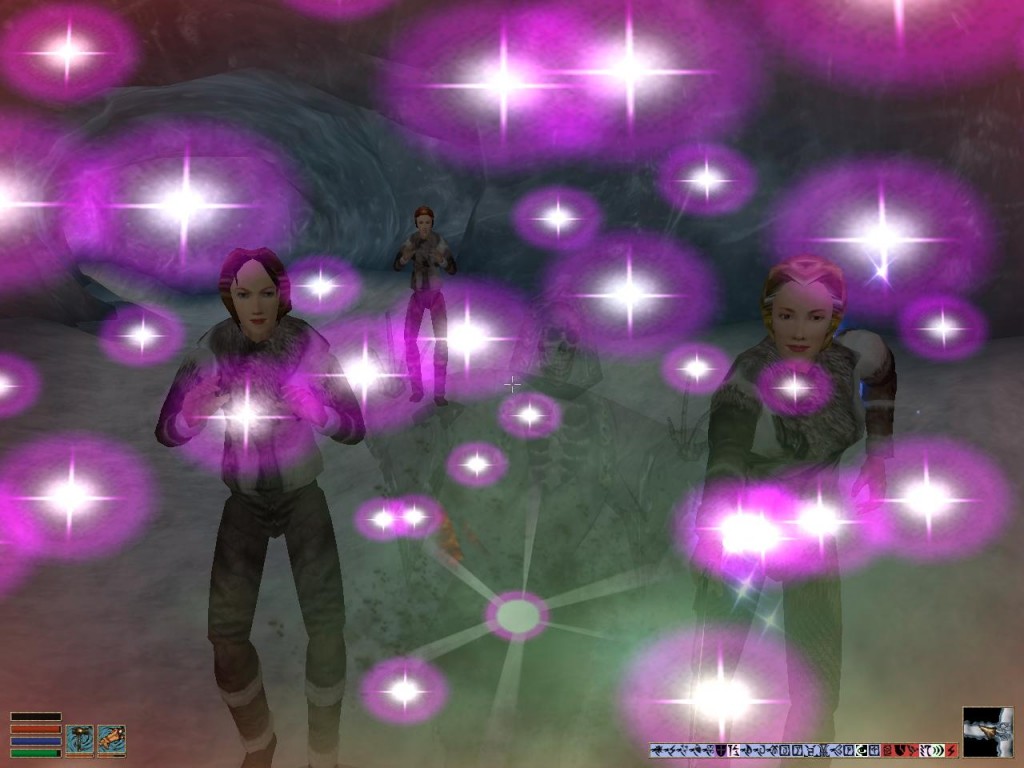 Mostly, I was on the receiving end of magic spells.
Mostly, I was on the receiving end of magic spells.
– Bribing people to give me information, because I was a diplomat with Personality as my dump stat
– Repeatedly fighting obnoxious pterodactyl-like enemies called Cliff Racers. Entire hours of my Morrowind experience were spent fighting—or running away from and subsequently being attacked from behind by—Cliff Racers. I’ll spare you the obvious joke where I list “Fighting Cliff Racers,” like, five times on this list to emphasize the point that they were everywhere.
 Instead, I’ll just insert a bunch of pictures of Cliff Racers. Here’s one.
Instead, I’ll just insert a bunch of pictures of Cliff Racers. Here’s one.
– Skimming through NPC dialogue until someone offered me a quest, and blindly accepting it without question (unless it was that one quest to escort that guy and his stupid pack guar all the way back to stupid Vivec City, which I had just come from—man, the nerve of some people…)
– Accidentally completing quests I didn’t realize I had accepted
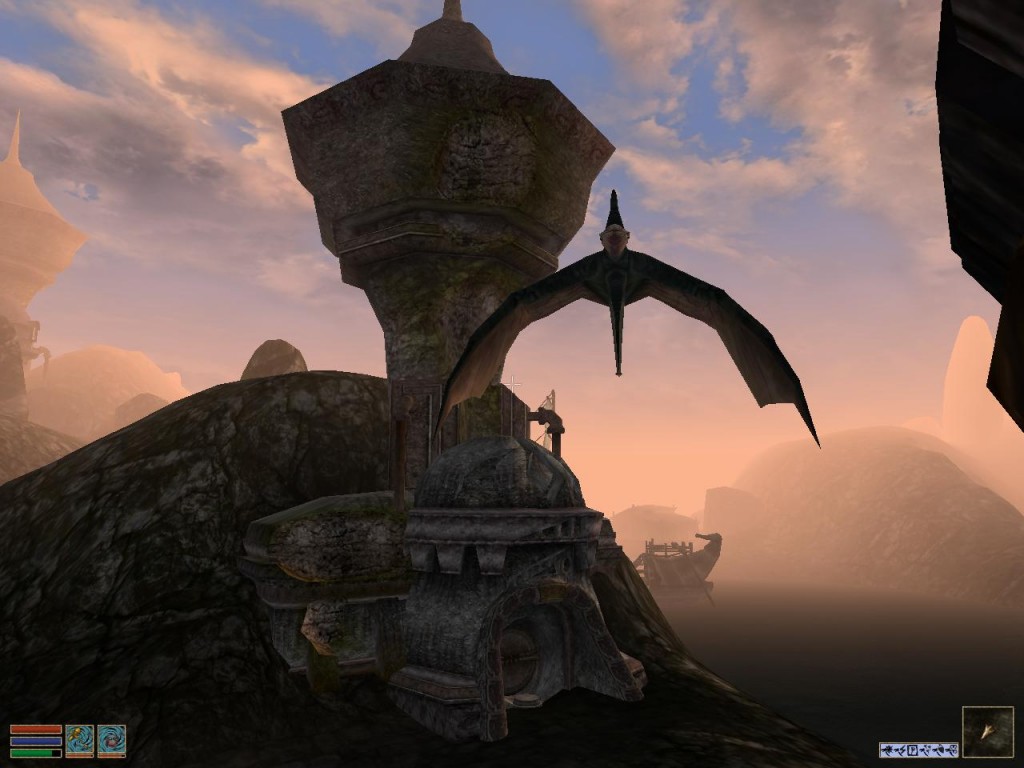 This is, like, every other screenshot I took, by the way.
This is, like, every other screenshot I took, by the way.
– Leveling up my skills by using them repeatedly; performing certain actions will fill up a sort of XP meter for your various skills, and once you max out the meter, your skill increases by one point. (Doing this enough to your class-related skills is how you level up, which I think is clever.) To increase my Acrobatics and Conjuration skills, for example, I would jump around the countryside (literally, mashing the Jump key), summoning pointless Ancestral Ghosts until I ran out of magic points. Later on, I discovered I could improve my Alchemy skill either by making potions (which I was terrible at) or by eating the ingredients that go into making potions—for a time, I was hopping around, summoning Ancestral Ghosts, and shoving nauseating quantities of chokeweed, raw crab meat, ghoul hearts, soap, gravedust, and bear pelts into my face.
 Oh, sure, it looks like a pretty vista, but there’s a Cliff Racer in the background.
Oh, sure, it looks like a pretty vista, but there’s a Cliff Racer in the background.
– Sneaking around people’s houses, stealing their property, trying not to get caught, getting caught, not realizing until halfway through Tribunal that there’s a key to activate my Stealth ability
– Torturing people who inconvenienced me to take them along on an escort quest, the most offensive instance being the time where I purchased a slave girl, dressed her up in fancy frippery, made her swim for something like a half-mile during a thunderstorm with toothy slaughterfish occasionally biting at her legs, and dragged her through the mud in a forced march to some backwater tribal camp, where I handed her over to be the consort of the tribe’s undoubtedly smelly ruler. He told me she was the most beautiful woman he’d ever seen—it was really quite heartwarming.
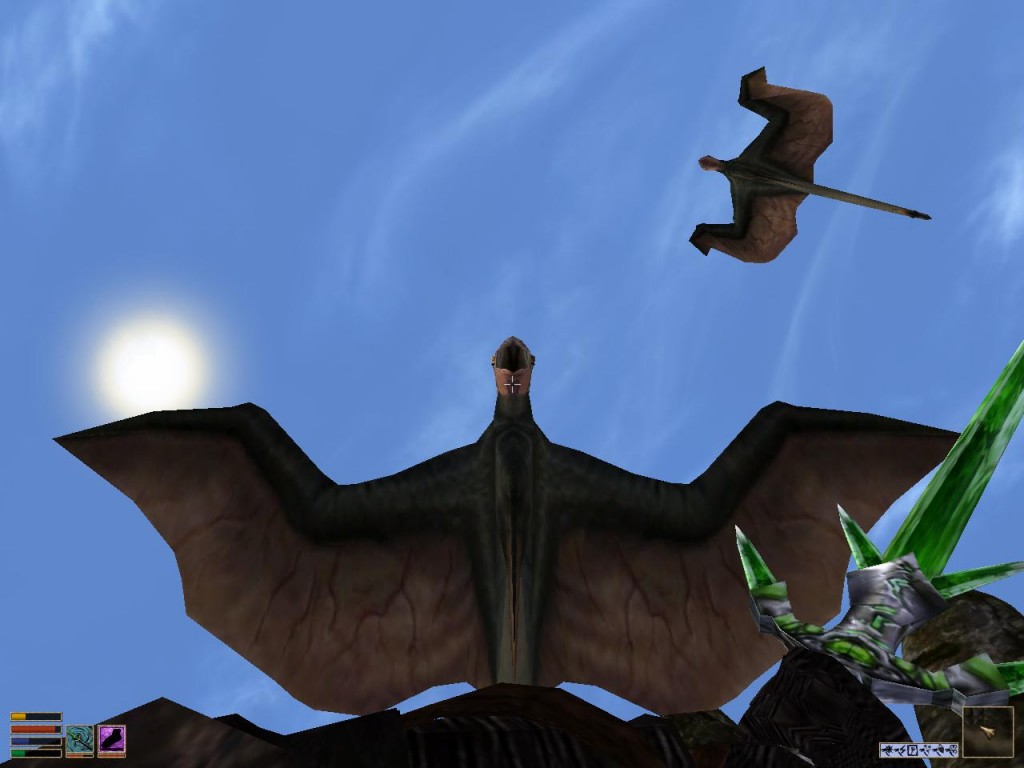 Aw, for cryin’ out loud, it’s like Inappropriate Llama Disaster over here with the Cliff Racers!
Aw, for cryin’ out loud, it’s like Inappropriate Llama Disaster over here with the Cliff Racers!
– Beating monsters and villains with a hammer
– Beating townspeople I didn’t like with a hammer
– No, seriously, beating townspeople I didn’t like with a hammer
– Stealing their clothes, too
– I am a terrible person
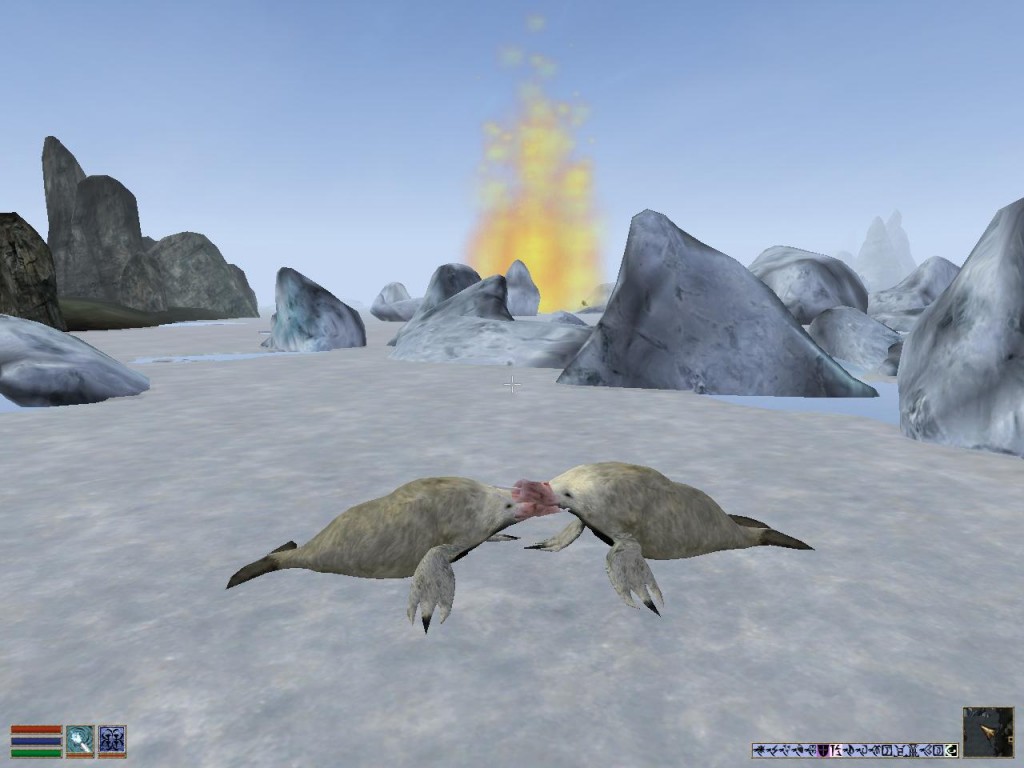 In the interest of decency, the image originally chosen for this spot has been replaced by a pair of nuzzling horkers.
In the interest of decency, the image originally chosen for this spot has been replaced by a pair of nuzzling horkers.
I suddenly had a profound understanding of the criminal mind: if you’ve gotta put food on the table (or, in this case, fancy armor on the Nord), and you don’t view your victims as real people with lives that matter (because you skim through all their dialogue), then what’s stopping you from a little theft or murder if the opportunity arises? The Law?? I beat up The Law and sell his goofy helmet to help pay my fine.
Very early in the game, I took on a quest to defeat the rats that were chewing up a woman’s precious stockpile of pillows. Two minutes and a handful of hammer swings later, the storeroom was secured and her pillows were safe again. She thanked me profusely, gave me a nice reward, and celebrated that her pillows were finally out of danger as I went back into the storeroom and stole all of them. As long as you can pull it off, why not run away with a pantload of pillows to sell on the black market? Or, in my case, hop like a fool out of the person’s home in order to improve your Acrobatics skills while making a getaway. Because that’s not suspicious.
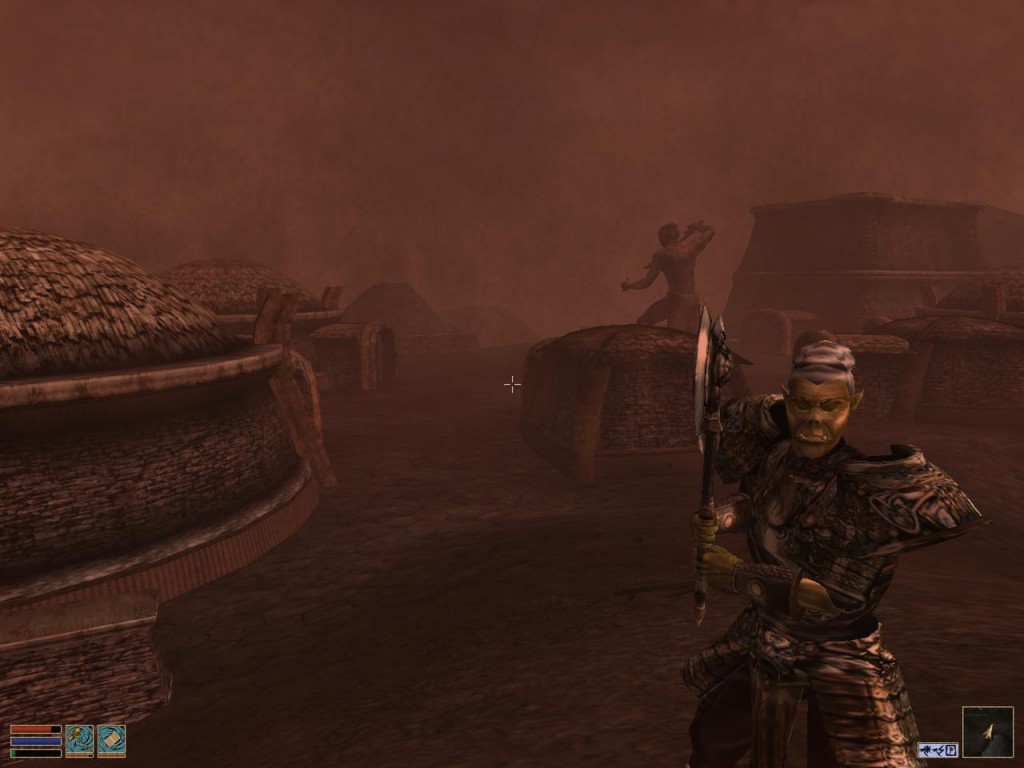 I eventually gave up on cornering the pillow market. Looting a stronghold like this one is far more lucrative—they’ve got cups and plates.
I eventually gave up on cornering the pillow market. Looting a stronghold like this one is far more lucrative—they’ve got cups and plates.
Unlike any other RPG I’ve ever played, you’re neither forced to be the good guy all the time, nor do your actions define whether you’re a Good Guy or a Bad Guy. You are, simply, a guy. (Or a girl. It’s always hard to tell with you.)
There were times when I rescued people and refused to accept a reward, just because it felt good to do the right thing. (See? I’m not all bad.) There were other times when I killed people because they offered me five stupid units of stupid Hackle-Ho leaf as a pathetic reward for fetching their stupid clothes, and then I reloaded a previous save because I didn’t feel like dealing with the consequences. (OK, I’m all bad.) You could probably conduct some interesting research about the human psyche by watching the way people play Morrowind; I think it’s safe to say the world is a better place because I let my socially unacceptable side run loose in videogames instead of in the real world.
 I do things in videogames that I’d never do in real life. Such as go outside.
I do things in videogames that I’d never do in real life. Such as go outside.
The freedom offered by The Elder Scrolls III is as intoxicating as the ten consecutive tankards of Nord mead my character consumed to prepare himself for the final boss of Bloodmoon, boosting his Strength score into the hundreds while dropping his Wisdom score into digits usually reserved for counting Kid Icarus sequels. Yes, the general expectation is that you’ll complete some quests and see the main storyline through to the end, but how you do that—if you do that at all—is entirely up to you.
Even after you’ve defeated the final boss (or, in my case, murdered a plot-critical NPC because he kept blocking a doorway), the game doesn’t end—you are at liberty to explore the world you’ve saved/doomed, indefinitely. The game offers story, sidequests, exploration, combat, diplomacy, subterfuge, shopping, guilds to join, mansions you can move into and decorate, magic items to create, magic spells to customize, actual books to read…anything you can think of doing in an RPG, it’s probably in here somewhere, and you can have as much or as little of it as you like. Not all that different from a buffet at a restaurant, really, except with more Cliff Racers between the ham cubes and the Jell-O.
 This is…not a Cliff Racer. Or a ham cube.
This is…not a Cliff Racer. Or a ham cube.
With so much freedom, it’s hard not to have some unique stories to tell. I could spend entire minutes reminiscing about crafting enchanted weapons named after Mega Man X bosses, or giving the pieces of my magical armor awful names such as “Greaves for No One.” I could regale you with the tale of the time I sold a health-draining robe to a shopkeeper, who immediately wore it, and shortly keeled over dead. The Elder Scrolls III can be just as rewarding to people who play the game normally as it is to oddballs like me who jump off of buildings just to see if they can land on townspeople’s heads.
Morrowind and its expansions do have their problems, but at least the technical issues have mostly been patched and modded out of existence. What’s left is largely a matter of personal preference and playing style—I like Morrowind for the huge area to explore, Tribunal for the ethical questions it raises as you decide how to complete the main quest, and Bloodmoon for the snow-coated landscapes; you might hate these games for all the same reasons. Pinning down anything that’s objectively bad is difficult, because the player is free to mold their experience into almost anything that fits within the basic framework of the game, even before they start fiddling with plugins, patches, mods, and the map editor. For the most part, you are responsible for whether or not The Elder Scrolls III is any good.
For instance, there are books. And you can read them. For fun. If you’re into that sort of thing.
The graphics have aged reasonably well (and screenshots don’t do justice to the beauty and complexity of some locations), but I’d advise against sitting too close to the screen, as some of those polygons are still sharp enough to poke your eye out. The soundtrack is elegant, majestic, and at times inspires a sense of wonder, danger, and didn’t I just hear this tune. While individual characters aren’t developed very far, the story of the game world itself is richly developed through conversations, books, and quests—whether it’s the curious disappearance of the entire dwarven race, or the mystery of why every other Nord finds himself paralyzed in the snow wearing nothing but a loincloth (or an anatomically correct groin, if you’re using that mod), there’s always something new to discover about the world, its ways, and its history. If you can handle old graphics, less music than is probably necessary for a game this long, and an overload of major and minor plot details (organized into digestible chunks in the Quest Log), then you’re in good shape to enjoy The Elder Scrolls III.
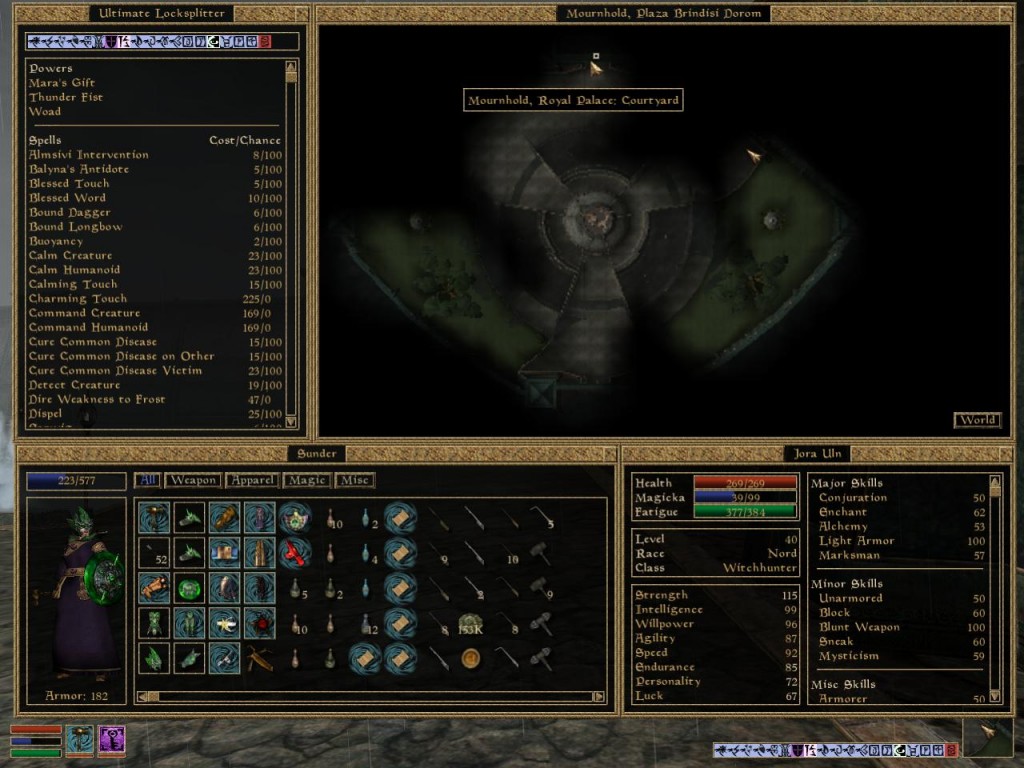 And if you can interpret these words and images at half their original size, then you’re in good shape to enjoy this screenshot.
And if you can interpret these words and images at half their original size, then you’re in good shape to enjoy this screenshot.
However, while the number of places to explore is staggering, the variety isn’t quite sufficient to completely justify such a sprawling overworld map. By the time you’re exploring Bandit Cave #516 or spending all your magic points levitating over Unremarkable Mountain Range That Covers a Quarter of the Map for the umpteenth time, even the game’s dated good looks start to wear thin as an excuse for seeing the same geography all the time. Part of the issue is that fast travel options, while relatively plentiful, only service very specific portions of the map (and often it’s a chore to make all the connections between Silt Striders, rowboats, Mage Guild teleporters, Prophylon Chambers, and JFK International just to get where you’re going).
The other part of the issue is that the majority of wandering monsters aren’t isolated to any one geographic location—Ash Zombies can be found nearly everywhere in Morrowind (including, but not limited to, all over the place), along with overgrown beetles called Scribs, and Kwama Larvae that’ll gnaw your ankles off, to name but a couple. Tribunal and Bloodmoon are generally better at keeping their wolves, goblins, and liches relegated to particular environments (both indoor and outdoor), but the fatigue of traveling through similar locations in Morrowind after 200 hours is worsened by fighting Cliff Racers in literally every place in the world that has a sky.
 Pictured: None of the enemies mentioned in the preceding paragraph.
Pictured: None of the enemies mentioned in the preceding paragraph.
That’s really the crux of The Elder Scrolls III—there is so much to do, but there is only so much that’s new to do. Repetition will be a part of your game experience, whether it’s haggling with shopkeepers over the price of dreugh wax, practicing your skills until you can do anything useful with them, or getting yourself un-stuck from the walls of one of those accursed Telvanni wizard towers. Still, if you can tolerate the endless random battles of Final Fantasy, the constant backtracking through Hyrule Field in Ocarina of Time, and me referring to Cliff Racers in every other paragraph, then The Elder Scrolls III shouldn’t feel like so much of a drag.
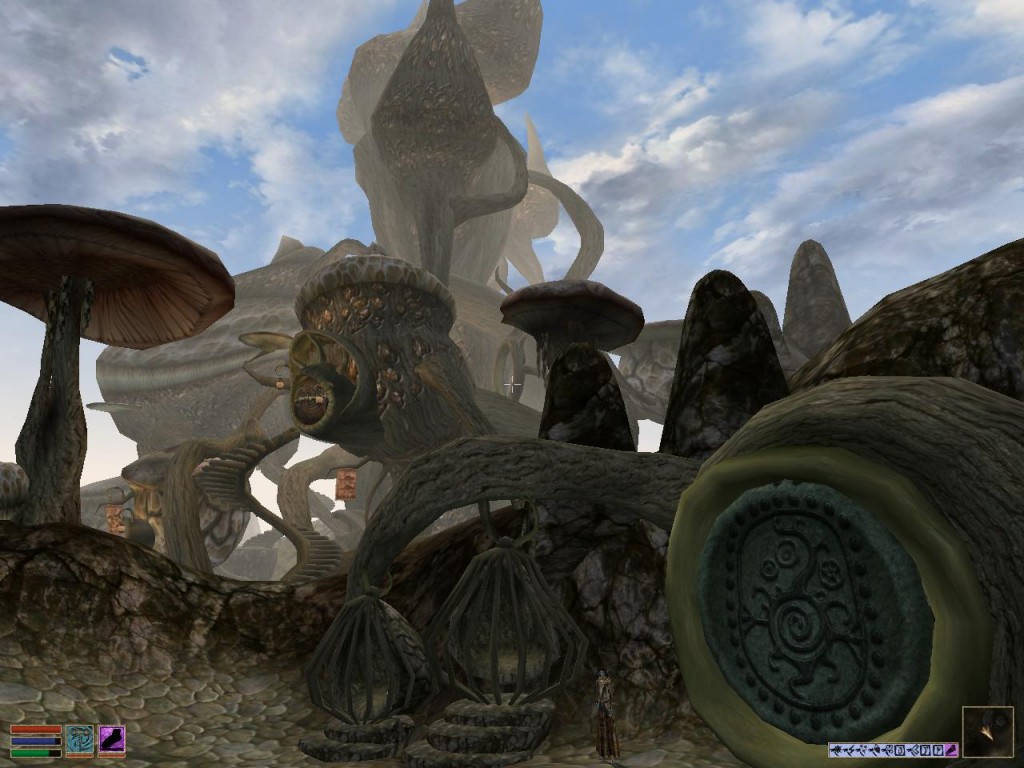 Telvanni buildings are like a hungry mountain lion: nice to look at, not so good to be inside.
Telvanni buildings are like a hungry mountain lion: nice to look at, not so good to be inside.
Morrowind, Tribunal, and Bloodmoon consumed ten months of my life, off and on. I only regret not looking at a walkthrough and the UESPWiki sooner—I caused myself a lot of unnecessary headaches due to my inability to figure out the item creation process, refrain from slaying the people I needed to talk with to complete my quests, and fulfill that confounded oath to Zenithar I apparently swore. (My wife continued to joke with me for the duration of the game that, anytime something bad happened in real life, it’s because Zenithar was angry with me.) The combined Elder Scrolls III experience was a refreshing break from the linearity and limited character customization of the RPGs I normally play, and even the repetition and overwhelming amount of initial information I had to process didn’t stop me from heartily appreciating and enjoying the game throughout all (well, most) of the 200 hours.
Ridiculous moments like this made it all worthwhile, though. That’s gotta hurt.
When I was finally ready to put the game to rest, I was a rich man with a beautiful home and a world full of people grateful for taking out my violent tendencies on the big bad guys for a change. There was no sense of guilt for skipping half the game’s content—no Dr. Robotnik juggling the Chaos Emeralds I missed, taunting me to try harder next time—just a sense of satisfaction at what I did accomplish. I can’t tell you how many RPGs recently have left me with a sense of relief, rather than satisfaction, for having finished them. Man, now I wanna go back and play the game again with a new character, maybe starting with Bloodmoon and working my way backward through Tribunal and then Morrowind. What’s another 200 hours, anyhow?
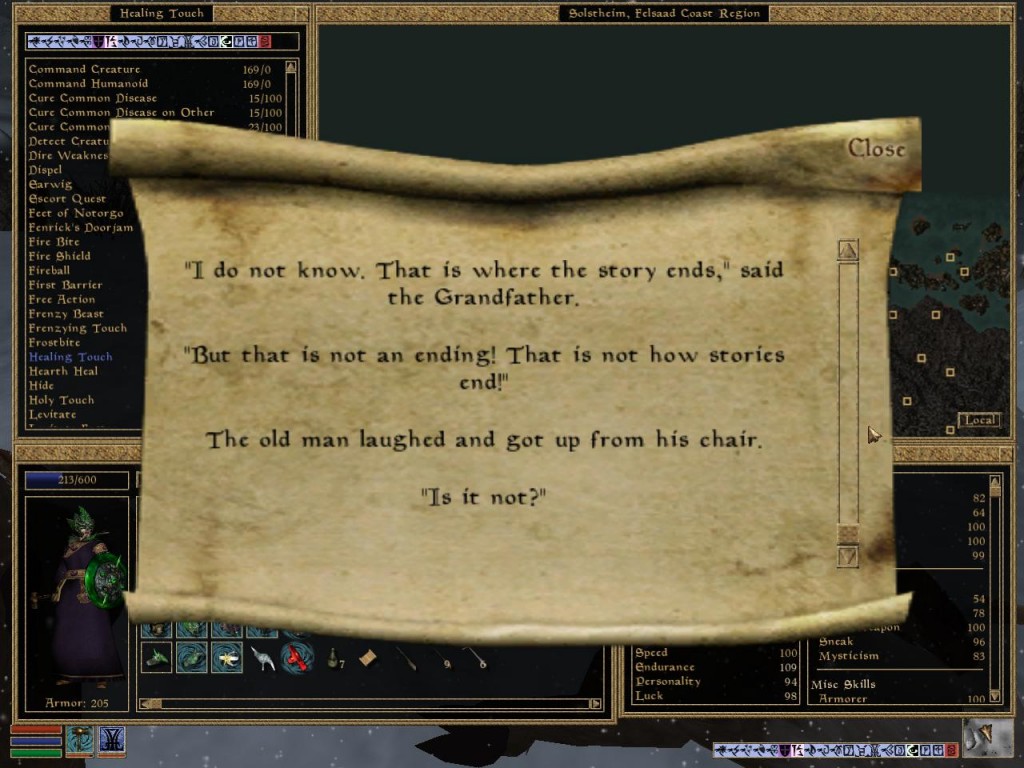

I started playing this game a several weeks ago with the Morrowind Overhaul? Have you checked it out? Insane graphics, sound, game patches and so forth. Definitely worth a look! MGSO 3.0
http://www.ornitocopter.net/morrowind-overhaul/
Nice! Yeah, I checked this out when you first posted about it and somehow failed to write a response until now. Lookin’ good!